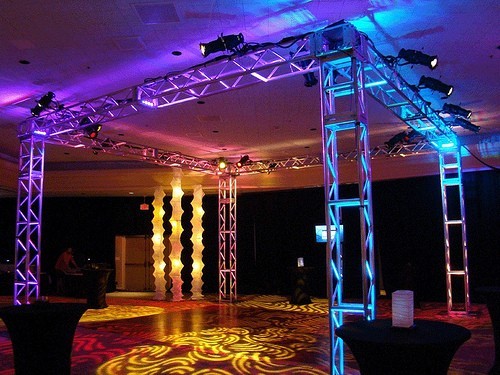THE LIGHTING GRID – FUNCTION AND CHARACTERISTICS
The fastening system on the top of the study is called grid.
Its function is to support the whole set of suspensions and projectors, necessary to provide lighting to the studio or set.
It must be solid, and firmly attached to the floor or, failing that, well supported on the floor or walls.
The grill can be of several types, depending principally on the height and economic availability of the property.
The higher the height, the more complexity, and the higher the cost.
PIPE GRID

It is the simplest grid to do. It may be of iron or aluminum, the latter being preferred because it does not rust, and is lighter.
Tubes in parallel, equidistant or not, or in a grid, subject to the ceiling by means of threaded rods are placed.
You can make a primary grid attached to forging, or supplement it with a secondary grid under it, with pipes subject to the primary by double claws, so releasing the grip, or loosening them, you can vary the position of the secondary.
This type of grid is the most economical and is used in heights up to 4 m. Where many changes will not be necessary in lighting, or large suspensions, such as pantographs or hoists.
RAILS FIXES/SLIDING GRID
The grid is formed by fixing rails, fixed to the upper floor. This will be placed mobile carts that will carry the suspensions, and these projectors.
This gives us a degree of longitudinal freedom and height.
You can also place transverse side rails, attached to the fixed primary, double carts that allow them to move longitudinally. In the latter rails by sliding carriages, bars, pantographs or suspended hoist, to withstand the spotlight.
In the latter case, we will have freedom in the xy plane and the z. The sliding carriages, as well as the slide rails can be moved from the ground through poles.

TRUSS GRID

This type of grid is typically used when assembling and dismantling should be done quickly, or when there are no anchors close enough to install a rack of tubes or rails.
It can also be a complement as first infrastructure when anchors are far apart, and you can not install a grid tube or rail directly. In this case acts as a truss.
Are manufactured in standard diameter of 50 mm, and serve directly as grid tube.
Heavily loaded because its function is the same as a truss.
There are standard sizes of 20, 25, 30, 40 and 50 cm side, parallel tube configurations, triangular, or square.
This grid may be fixed or motorized, to lift the whole, or part, with engines usually chain.

